Category Archives for "Freebie Included!"
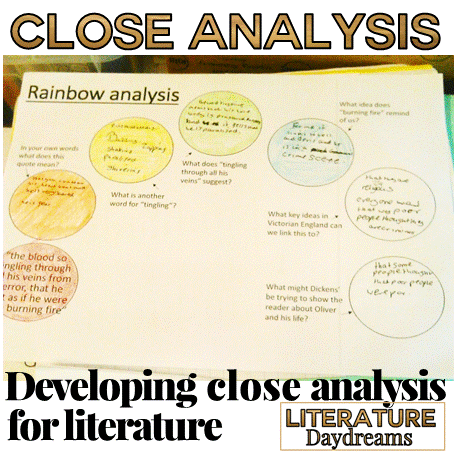
Developing close analysis skills when teaching literature texts can be tricky. Think of all the things a student needs to know first:
Here’s what we talk through first – explicit and implicit information. I introduce this very simply. Explicit information is clearly written in the text. “Last weekend, it rained a lot.” The text states it rained, so we know it rained. Implicit information needs a little detective work – we use our existing knowledge of the world around us to work out what is being suggested.
We look at the above example. The explicit information is that two people (named Mark and Clara) paid for some tickets for ‘something’ and after that they went to buy some popcorn. We use our existing knowledge of the world to workout that Mark and Clara at the cinema. They could be at a show, the theatre, or at a gig, but we suspect not. And I ask students to explain why not.
Here’s what they generally come up with: most people who go out, go to the cinema (after all tickets for shows, theatre and gigs are expense). If you are going to a gig, you won’t be buying popcorn. This is also probably true for theatres and shows – we leave this for the interval.
After working through this inference together – students try the following:
This week I have also been using this amazing trailer from Miss Peregine’s Home for Peculiar Children. There is so much that is hinted at this trailer – it’s great to discuss.
So now we develop our inference skills into analysis skills!
I first came across the idea of Rainbow Analysis on Twitter about a year ago. You can see the details here.
It is a structured and visual way to ensure that students are creating detailed inferences and then turning this into close analysis. As you can see the sheet has 7 circles in an arc shape. You can pretty much use these circles for any purpose that suits your outcome.
Here is what I include:
Circle 1: quotation
Circle 2: what does the quote mean in your own words?
Circle 3: choose one word (or short phrase) from the quotation and identify the technique used by the author (eg simile)
Circle 4: Now zoom in on the implied meaning of the word or phrase and explain what is suggested by it.
Circle 5: Are there alternative interpretations that could be made of the quotation? Does it contain ambiguous language or ambiguity of meaning?
Circle 6: How does the quotation link to contextual factors such as the period in history or the author’s biographical context?
Circle 7: How does the quotation challenge or impact the reader’s thinking about the character or situation?
Of course, then we colour it all in – to remind ourselves that we are understanding the shades of meaning. Soooo, friends, would you like to give it a go? Well, signup to my newsletter below and you can download the resources from my FREE resource library.
If you are interested in seeing some of my literature resources in action, find me on Facebook and Instagram. Check out my TpT store and sign up for my newsletter for exclusive material and tips and tricks!
Schools are wonderfully diverse communities. In fact, when I remember my ‘other’ job in the real world, I see what a bubble I existed in for such a long time. Working away, like a hamster on a wheel, with people doing jobs like me, who were pretty much, just like me.
I don’t have a choice who rocks up at my classroom door. Even teaching in a school with a very small catchment area, I see the full and wide range of human experience reflected in the kids I teach.
This year, more than any before, I have wanted to champion both diversity and community in my ELA classroom. To give space for challenge and difference and to enjoy togetherness and unity. An idea for this – linked to writing – segued from a unit we were already studying. In Year 7 / Grade 7 we analyze a series of poems from different cultures, if you never heard or seen them I would recommend the following: Blessing by Imtiaz Dharker and Night of the Scorpion by Nissim Ekeziel.
I wanted my students to have the opportunity to give voice to their culture, just as these poets had. But in teasing out these thoughts, I quickly realised that even within one class of 30 students, we had no fixed culture. Yes we live in the same town, but some of us speak different languages at home, eat different food, love different music. I needed to find a way to hold both our difference and our unity up for the world to admire.
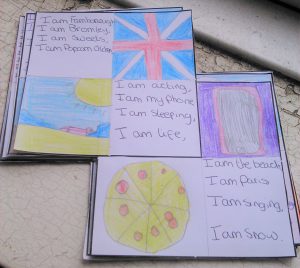
It could not have been any more simple in the end, the “I am” poem allowed my students to express both at once, in a muddle and a mix, just as it is.
Here’s what I asked students to do:
Once everyone had ideas in each box, we then discussed how to chose the ones that best represent ‘me’. I didn’t want to tell kids that ‘my iphone’ was wrong because that would have gone wholly against what I was aiming for – a celebration of them.
After the list generation phase, I would show the class my responses. Below is my original list (occasionally, now, I edit it and add sky diving or lion taming, just for fun).
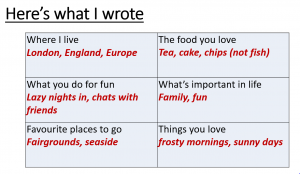
Then I model turning this list- in-a-box into a list poem. Firstly, we discuss nouns and articles and how in poetry missing them out can create meaning “I am tea and cake”, but occasionally they will be required because it just doesn’t sound right: “I am iPhone” becomes “my iPhone”. Again we discussed why “I am a sunny day” requires the article but “I am frosty mornings” doesn’t – looking at pluralisation and its impact.
Here’s my poem – which, yes, I show kids before they write their own one. I often ask students to consider what can be inferred from the various lines. My students tend to jump on “England and Europe” – I leave them to their speculations and then let them write their own.
I have no rules about the drafting and refining of these poems. I wanted a truthful expression. So after a lesson pottering about with words, we left the poems to ruminate for a while. Coming back to them the following day, allowed us one more opportunity to finesse and then we got creative.
I gave students this worksheet (click to download) and showed them the plan was to create a hanging squared poem to display.
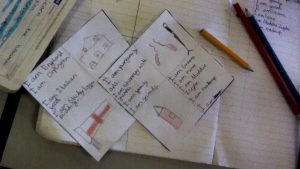
So they need to:
The result? A poem that shows the individual and yet celebrates the things that bring us together (cake, football, chicken) and the things that make us different (Russian, cheerleading champion, pro-golfer). I love it and I love them in all their samey-difference.
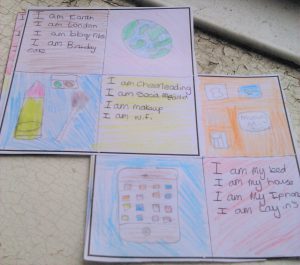
We laminate them and hang them around the room, sometimes stringing several together and leaving them to flutter in the breeze. Words and colour mixed together reminding us that diversity and community are beautiful.
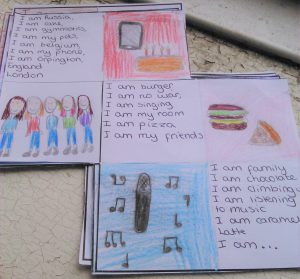 Sign up for my newsletter and receive regular updates, access to my free library and exclusive offers.
Sign up for my newsletter and receive regular updates, access to my free library and exclusive offers.

*I send emails with teaching tips, tricks, and free resources to my subscribers regularly. I value your privacy and you can learn more about how I handle your data in our private policy. You can unsubscribe at any time.
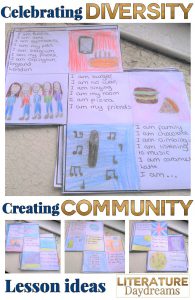
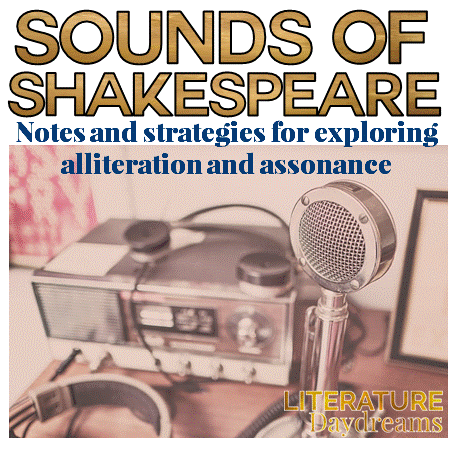
When students first begin studying Shakespeare, we spend most of our time focusing on understanding the language, talking about the characters and events, maybe even discussing the themes. What do we do when our students are capable of going further? What’s the next step in analysis and exploration? Well in answer to that question – I wanted to develop a bit on my last Shakey blogpost – and give you a little freebie to help.
My first stop, after we have moved on from comprehension and inference, into analysis is to focus on the Sounds of Shakespeare. His work after all was written to be performed and this element is essential to our understanding of it. It is the performance of his words that allows us to see and to hear the emotion, the performance is where interpretation becomes more fluid, less set. We’ve all seen this FB post:
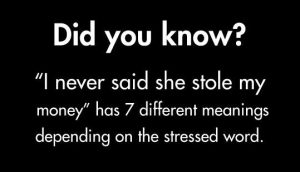
Despite how easy it would be if the meaning Shakespeare’s words were fixed, they are not, and our most-able students are capable of discussing this.
Often – for me – this discussion of sound begins with the most simple sound patterns: alliteration and assonance. Specifically these patterns were used (like rhyme) as an aid to memory, actors used these sounds to help them memorize their lines. The rhythm created by the use of these patterns enables the words to flow without having to actively or consciously think about what words come next.
As a lesson opener, write the beginning of a nursery rhyme on the board. Now if you teach a diverse bunch of kids, like I do, you will need to choose carefully. (Remind me to tell you about the time I assume all my students had read Goldilocks…) My starter goes something like this:
1. Write the words ‘incey wincey spider’ on your whiteboard.

2. Ask the class to dictate the rest. Then ask them when was the last time they actually remember saying this nursery rhyme? I guarantee – even for those with younger siblings – these teens are not going around singing nursery rhymes all day.
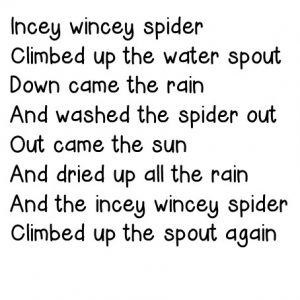
3. I then pose the question, why it is easy to remember, when we haven’t said it for years? I often say tell them at this point, that I lived at my old address for 8 years but today I can’t remember my postcode (zip code). Why can I remember this nursery rhyme?
The answer is often because of the rhyming words or repeated words, it is easy to remember. But then we look at little further.
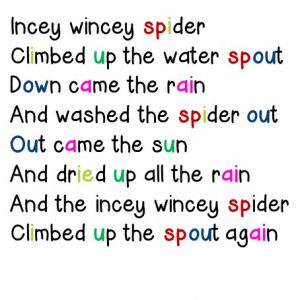
Yes there are a ton of repeated words – and this one reason why I use this particular rhyme, because sometimes one glaring technique (a powerful metaphor or a biblical allusion) can take away from everything else that is going on.
Look at the assonance and alliteration here – the long /i/ sound in ‘spider’ is echoed with ‘dried’ and ‘climbed’; the /ow/ sound in ‘spout’ is seen again in ‘out’ and ‘down’. These assonance echoes aid memory just as much as the rhyming of ‘rain’ and ‘again’. The alliterative elements are also easy to miss ‘spider’ and ‘spout’ – no rhyme, but for purposes of memory it works. I haven’t even highlighted the alliterative /d/ sounds throughout.
Once my students are comfortable with alliteration and assonance BUT before we dive into our Shakespeare play, I use extracts from famous Shakespearean speeches to force their focus onto sounds { see what I did there? force their focus }.
Why don’t I use the play we are currently studying? Well, I could I guess. But the problem is, my students know too much. They know all the characters and themes and once I ask them to start looking at the alliteration and assonance, they are going to get distracted by their knowledge! Wow! I never, ever, thought that would be a bad thing (and it isn’t really). I want them focus on the sounds alone. What do those sounds reveal? Without using prior knowledge, tell me about the sounds.
So download my freebie – right now – and that way you have it all ready to go. You can go through the info pages with your students as much as you like, then pick one of the coloring exercises for your students to complete, including is an extract from R&J and Sonnet 116.
Here students move from looking generally at repeated sound patterns to focusing on specific patterns and what they might mean. There are two explanation sheets included – the yellow one seen in the above picture takes students through the 8 types of alliteration and why they are used. Students can practise identifying alliterative patterns and then giving them meaning. The upside – anything using coloring pencils can’t be real work, right?
Ok. Coloring pencils away now. I am always super impressed with the ideas my students have following these exercises. They create real inferences, real analysis during these tasks. So to keep pushing them on, and building their confidence, we then move onto a simple annotation and exploration exercise.
Annotating a shorter passage (from Macbeth or Henry V) for alliteration, assonance and how these reveal emotion. These sheets give students an opportunity to develop their analysis and write up their ideas but in a low-pressure, low-stakes table. It again generates and aids great discussion.
Analyzing a whole speech – so if you are studying a Shakespeare play, then this would be the opportunity to introduce a speech or soliloquy from that play. For example – when teaching Macbeth, I might pre-teach these skills on the lead up to analyzing “Is this a dagger?” in Act 2, or with Antony and Cleopatra, I often use this as preparation for Enobarbus’ barge speech.
I’ve included part of Mark Antony’s funeral speech from Julius Caesar, as an example for you, partly because this is the first play we teach when our students arrive in Year 7 / Grade 6 at our school. I love the play and by this point in the play (three Acts in) my students are pretty confident with understanding the language and ideas.
So start with a tiny, plucky spider and finish with some fierce and confident analysis.
Teach on my friends.
Do sign up for my newsletter, you will gain access to my free resource library – I have put the answer keys for Sounds of Shakespeare on there, and much, much more!